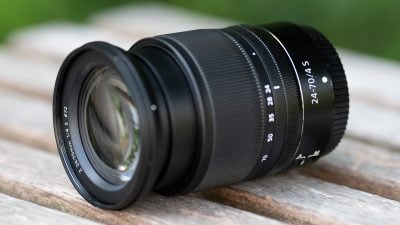Nikon Z 24-70mm f4S review
-
-
Written by Thomas
In depth
The Nikon Z 24-70mm f4S is a small and light non-stabilized standard zoom lens with a constant f4.0 focal ratio that’s designed for Nikon’s new Z-mount full-frame cameras. Announced in August 2018 it joins the Z 35mm f1.8S as the first Z-series lenses on the market; the Z 50mm f1.8S will be the third at end of 2018. Nikon’s Z-lenses may be the only models currently available with a native Z-mount but thanks to Nikon’s FTZ adapter, existing F-mount lenses can easily be used on their new Z bodies. So the new Z 24-70mm f4S faces competition from other standard zooms with the F-mount, most notably Nikon’s own AF-S 24-70mm f2.8E VR which is the benchmark of 24-70mm zoom for Nikon cameras.
As the Z 24-70mm f4S is a member of Nikon’s high-end “S” line it is expected to perform on a very high level. That said, Nikon is pricing it competitively at 1099 EUR when bought alone, or a bargain 600 EUR when bought in a kit with a Z body. Compare this to the 2150 EUR for the AF-S 24-70mm f2.8E VR. This can in part be explained by the one stop slower focal ratio of the new Z lens and its lack of optical stabilization (deemed unnecessary here as it’s built into the Z bodies), but it still represents good value, particularly in a kit. Side note: with a focal ratio of f4.0 it is the only available 24-70mm f4 zoom for Nikon full-frame bodies – and easily the smallest and lightest, playing to the strengths of Nikon’s new mirrorless Z system.
To find out whether the new Nikon Z 24-70mm f4S rightfully carries the “S” moniker I tested it on the 46MP Z7 body against Nikon’s own 24-70mm f2.8E VR which is my current reference 24-70mm lens shot on the 46MP D850. So if you’re interested in how Nikon’s brand new system performs, you’ve come to the right place! PS – if you’re interested in the other Z lenses in Nikon’s line-up check out our in-depth reviews: Nikon Z 14-30mm f4.0 S review / Nikon Z 24-70mm f2.8 S review / Nikon Z 35mm f1.8 S review / Nikon Z 50mm f1.8 S review / Nikon Z 85mm f1.8 S review.
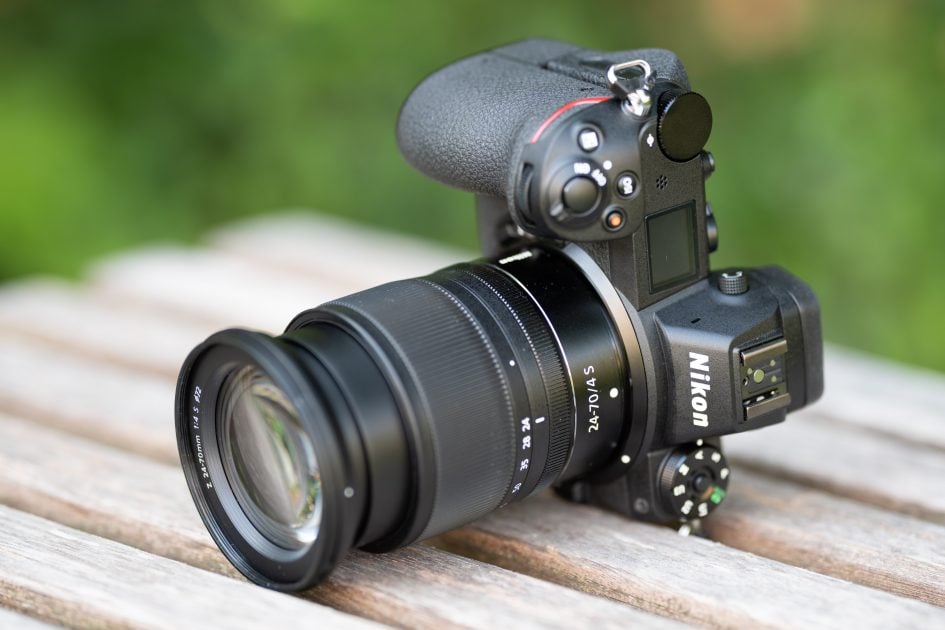
Facts from the catalog
As usual I’ll have a look at the technical data of the new Nikon Z 24-70mm f4S first. I’ve rated the features with a [+] (or [++]), when it’s better than average or even state of the art, a [0] if it’s standard or just average, and [-] if there’s a disadvantage. For comparison I use the Nikon 24-70mm f2.8E VR.
Size (diameter x length): 78 x 88mm (3.1 x 3.5in.) plus 41mm for the lens hood which is 102mm in diameter. The short length of 88mm is reached only in its collapsed state which shaves 20mm off the minimum operating length of 108mm at 24mm focal length. Zooming out to 70mm adds another 30mm which brings the lens up to a total length of 179mm (7.0in.) at 70mm focal length with lens hood attached. The Nikon 24-70mm f2.8E VR is still larger at 98 x 154mm + 49mm for the lens hood giving a total length of 203mm (8.0in.) independent of focal length. For an apples-to-apples comparison one has to allow for the differences of flange distance between the Z-mount (16mm) and the F-mount (46.5mm). So these 30.5mm have to be added when using the 24-70mm f2.8E VR – either by using it on an F-mount DSLR like the D850 or by mounting it via the FTZ adapter on a Z7. All-in-all this makes for a huge difference when carrying the lens. [+]
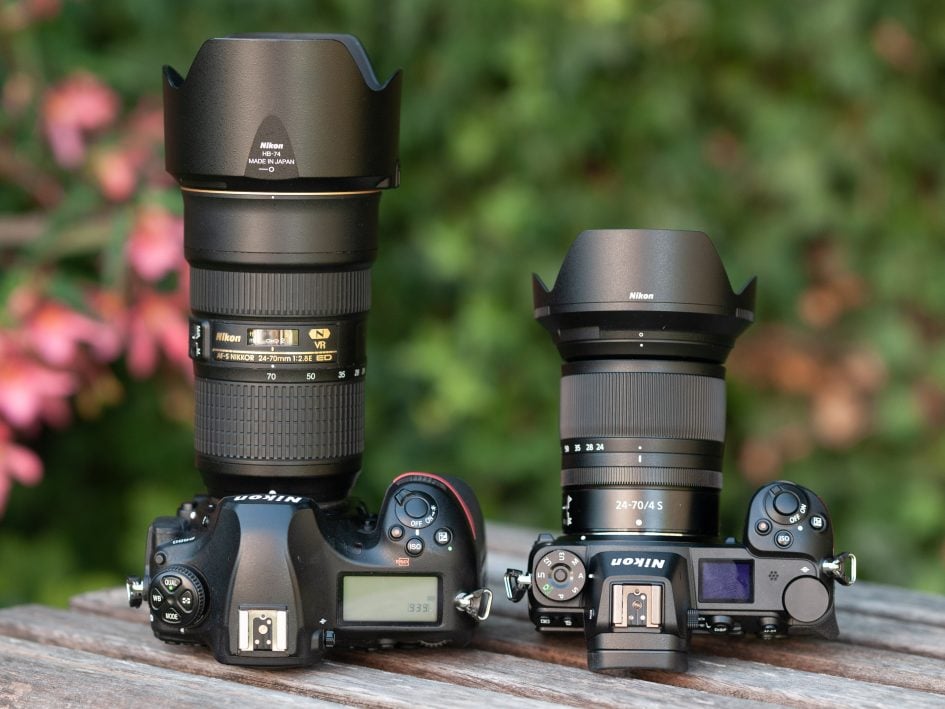
Above: Nikon 24-70mm f2.8 E VR on D850 (left) vs. Nikon Z 24-70mm f4S on Z7 (right)
Weight: 497g (17.5 oz.) plus 28g for the lens hood. The Nikon 24-70mm f2.8E VR is 1066g (37.6 oz.) plus 60g for the lens hood plus another 133g for the FTZ adapter to use it on a Z7. So the new Nikon Z 24-70mm f4S is by far the lightest way to go 24-70mm on a Nikon but that is certainly due to the smaller focal ratio of f4.0. Total weight mounted on a camera is 1200g (42 oz.) for the Nikon Z 24-70mm f4S on a Z7 vs. 2071g (73 oz.) for the Nikon 24-70mm f2.8E VR on a D850. [+]
Optics: 14 elements (including 2 special dispersion and 3 aspherical elements) in 11 groups vs. 20/16 for the Nikon 24-70mm f2.8E VR. So the new Z lens has substantially less glass/air surfaces which is always a good thing to reduce the chances for reflections. Both lenses employ fluorine coating on the front to repel water, dust, and dirt and should make for easier cleaning and use Nikon’s Nano-coating to reduce flare, glare and ghosting. [+]
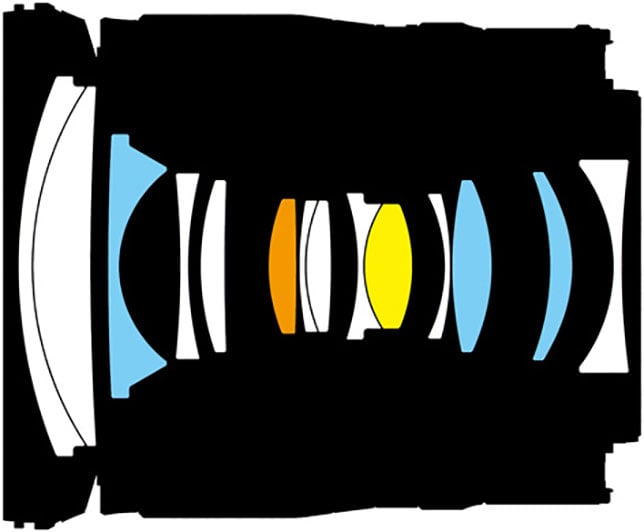
Closest focus distance is 0.30m (11in.) with a magnification of 1:3.3 at 70mm focal length. In my test I was able to get down to 1:3.1 at 0.29m with manual focus. The magnification of the new Nikon is quite good but you have only 14cm (5.5in.) of working distance at minimum focus distance. A magnification of 1:10 is achieved at 0.80m giving a working distance of 0.61m with lens hood attached. The Nikon 24-70mm f2.8E VR achieves a similar magnification in manual focus with a slightly longer working distance and minimum focus distance. [+]
Filter-thread: 72mm which is cheaper than the 82mm filters the Nikon 24-70mm f2.8E VR needs. [+]
Image stabilization: The lens offers no optical stabilization. But the Nikon Z bodies provide built-in sensor-shift stabilization over 5 axis – plus an optional electronic stabilization option in video mode. The Nikon 24-70mm f2.8E VR has optical image stabilization built in (pitch and yaw) which can be used together with the body-based image stabilization of a Nikon Z body. But in this case the body provides only roll correction, not the full 5 axis. [0]
Auto focus: Yes with built-in AF drive. Manual-focus override is by simply turning the focus ring – if you didn’t assign another operation to this multi-function ring. The focus ring has a variable gearing that allows for very precise manual focus when turned slowly. Unfortunately this feature cannot be switched to linear gearing which makes smooth focus pulling for videographers almost impossible. Focus on the Nikon 24-70mm f2.8E VR works similarly with the only differences being a linear gearing and that the focus ring does only that: focusing. [+]
Covers full frame/FX or smaller. Same with the competition. [+]
Price: The lens has a list price of 1099 EUR (incl. 19% VAT) / 999 USD. But if you buy it in a kit together with the Z7 camera it’s only an additional 600 EUR / 750 USD. That’s a very good deal. The Nikon 24-70mm f2.8E VR goes for a whopping 2150 EUR / 2400 USD, although again it’s a stop brighter and has optical stabilisation. [+]
Comes with a soft pouch and the lens hood is included, reversible for transport. That’s similar to most other lenses. But the Nikon 24-70mm f2.8E VR has a much nicer padded lens case and its lens hood locks in place to avoid accidentally falling off. [0]
Distance information is relayed to the camera, so the camera and flashes can do all the advanced exposure-related stuff with this lens. Same for the competition. [+]
Aperture ring: the multi-function control ring of an S-lens can be assigned to operate the aperture, exposure compensation, ISO or focus. It automatically falls back to its customary focus control when the lens is switched to manual focus. Although the lens control ring has not the same benefit as having a focus ring plus a dedicated aperture ring on the lens it gives you more flexibility to control one of the more important shooting parameters directly from a nice ring on the lens. The aperture is actuated electromagnetically which makes it the equivalent of a modern E-type Nikon lens and puts away with the mechanical coupling that Nikon uses on all older lenses . The Nikon 24-70mm f2.8E VR also uses electro-magnetic actuation but has no aperture control ring. [+]
Sealing: yes, a rubber grommet at the lens-mount plus further special weather-sealing throughout the construction, just like the 24-70mm f2.8E VR. [+]
The score in the “features-department” is 0[-]/2[0]/11[+]. So the lens has a very good feature set – if you accept its focal ratio of f4.0. But that certainly is the enabler to make the lens much smaller and lighter than the alternatives. It offers the nifty feature of the multi-purpose control ring and is sealed against the weather like its bigger sibling, the professional grade Nikon 24-70mm f2-8E VR. And surprisingly for a member of Nikon’s new “S”-line it also comes at a very good price if you simply buy it in a kit with the new Nikon Z7 body.
Two Nikon 24-70mm zoom lenses
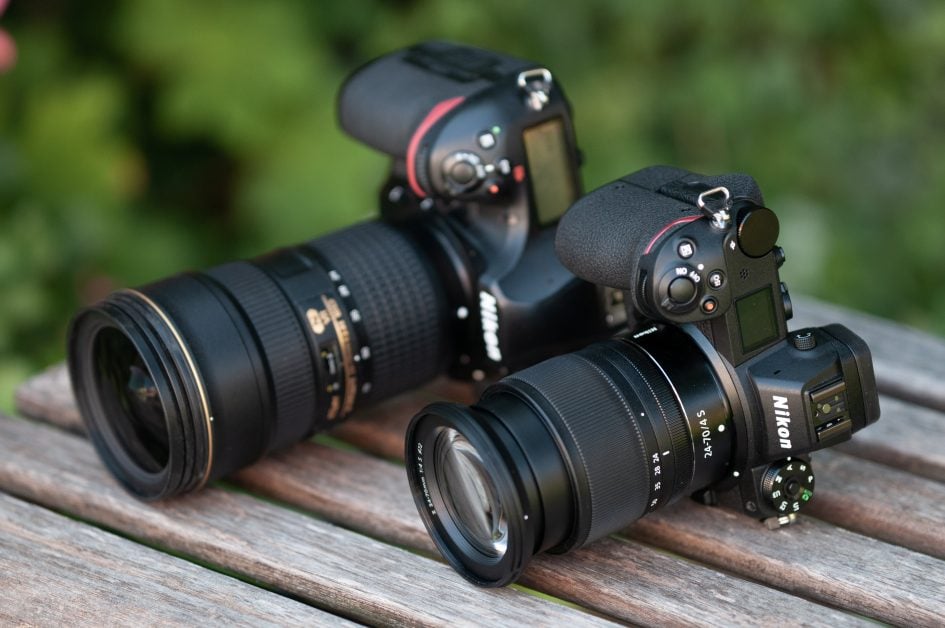
Above: Nikon 24-70mm f2.8E VR (left) vs. Nikon Z 24-70mm f4S (right)
Alternatives
The market for full-frame 24-70mm zooms is pretty crowded but no other manufacturer offers a small and light f4.0 version for Nikon bodies (mirrorless or DSLR) that competes directly with Nikon’s new Z 24-70mm f4S:
- Nikon has the AF-S 24-70mm f2.8E ED VR from 2015 for 2150 EUR / 2400 USD. For more information see my Nikon 24-70mm f2.8E VR review where it got a Highly Recommended. You can still get the older AF-S 24-70mm f2.8G ED version from 2007 which is not stabilized and sells for 1700 EUR / 1800 USD which came Highly Recommended tested on a 36MP D800 in my Nikon 24-70mm f2.8G ED review.
- Sigma offers the stabilized Sigma 24-70mm f2.8 DG OS HSM Art (1230 EUR / 1300 USD). See my Sigma 24-70mm f2.8 Art review where it earned a recommendation.
- Tamron’s latest model is the stabilized SP AF 24-70mm 2.8 Di VC USD G2 for about 1150 EUR / 1200 USD. It earned a Recommended in my Tamron SP 24-70mm f2.8 VC G2 review.
- Tokina offers the AT-X Pro 24-70mm 2.8 FX from 2015 (900 EUR / 850 USD) which lacks built-in stabilization. But mounting it via FTZ adapter stabilizes pitch, yaw and roll through the Z7.
Here is the angle of view that the new Nikon Z 24-70mm f4S covers with its 2.9x zoom:

Above: Nikon Z 24-70mm f4S coverage on Nikon Z7 (FF/FX) body at 24mm (left) and 70mm (right)
Focus and zoom
Focus accuracy and repeatability is critical to consistently produce sharp shots. Repeatability (the accuracy of focus on the same subject after repeated focus-acquisition) of this lens at 70mm focal length is very good (measured 99.1% in Reikan FoCal) with no outliers over a series of 40 shots. There is no focus variation whether the lens focuses from a closer distance or from infinity and I didn’t detect any hunting. At 70mm focal length the lens focuses in around 0.35 sec from infinity to 0.8m (1:10 magnification), which is as fast as the very fast AF-S 24-70mm f2.8E ED VR on a D850 or a Z7 (via FTZ adapter).
The zoom ring turns through 55 degrees the way Nikon users are used to and has a 28mm wide rubber surface with a good grip. It turns pretty stiff and can hardly be operated with one finger. The focus/control ring is only 8mm wide and is located closer to the camera. It has no rubberized surface but moves super smooth and can easily be operated even with your pinky.
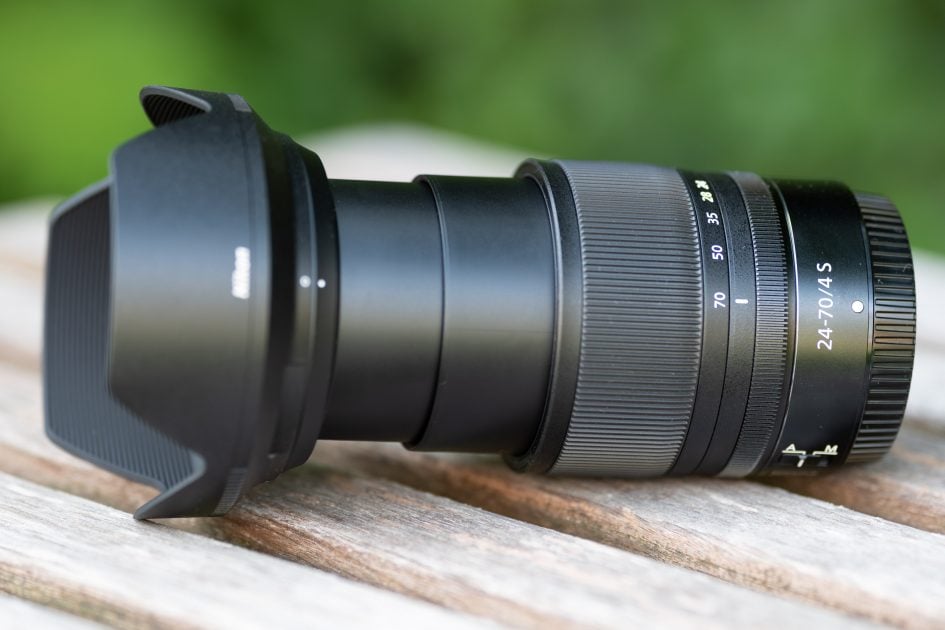
AF-operation of the new lens and image stabilization of the Z7 is inaudible from the outside. If you record video with the built-in microphone the AF-drive produces only a very slight noise. Plus you can control the aperture smoothly and without noise from the control ring on the lens. This is the quietest AF/IS/aperture operation I’ve ever encountered on a Nikon body so far. Mount the Nikon 24-70mm f2.8E VR via the FTZ adapter and you notice a huge difference in noise.
As you pull focus, you’ll notice some focus breathing: the image becomes less magnified at closer focusing distances. When I adjusted the focus from infinity to 0.8m on the new Nikon at 70mm focal length, I measured a 2% decrease in magnification. The same test at 24mm focal length did not produce any visible focus breathing. Very good! The Nikon 24-70mm f2.8E VR in comparison shows a 1.4% increase in magnification at 70mm focal length, while decreasing magnification by 2.6% at 24mm focal length. So both these lenses produce very little focus breathing when recording video.
Image stabilization
To test the effectiveness of the image stabilization with the Nikon Z 24-70mm f4S on a Z7 body, I did a series of 140 test-shots hand-held at 70mm focal length. I tested with shutter speeds from 1/80 of a second down to 0.4 sec. Shots at 1/80 sec with VR=OFF are used as reference of how good my hand-holding was at the time of the test and Reikan FoCal did the chore of evaluating the sharpness of all shots. Here’re the details: With VR=ON (in camera) the combo produced results down to 1/5 sec (4 stops) which were better or at least comparable to 1/80 sec with VR=OFF. At 0.4 sec there were 30% clearly blurred images. This is a 4-5 stop advantage from stabilization.
I also tested the Nikon 24-70mm f2.8E VR via the FTZ adapter on the Z7. In earlier tests on a D810 the lens produced a 3-4 stop advantage from its built-in VR and I was curious how a stabilized F-mount lens profits from the additional roll compensation that the Z7 body provides in a test set-up that was identical to the one above. The results: The image stabilization was slightly better than from the Z 24-70mm f4S + Z7 combo down to 1/10 sec (3 stops) but had 20% misses at 1/5 sec and 60% misses at 0.4 sec. This is a 3-4 stop advantage from stabilization. That may not seem better than from my earlier test on the D810 but on the Z7 the results were very sharp down to 1/10 sec more consistently than on the D810. It looks like the additional roll compensation from the Z7 has a positive effect on the image stabilization of adapted F-lenses.
Next check out my quality results!
Check prices on the Nikon Z 24-70mm f4S at Amazon, B&H, Adorama, or Wex. Alternatively get yourself a copy of my In Camera book or treat me to a coffee! Thanks!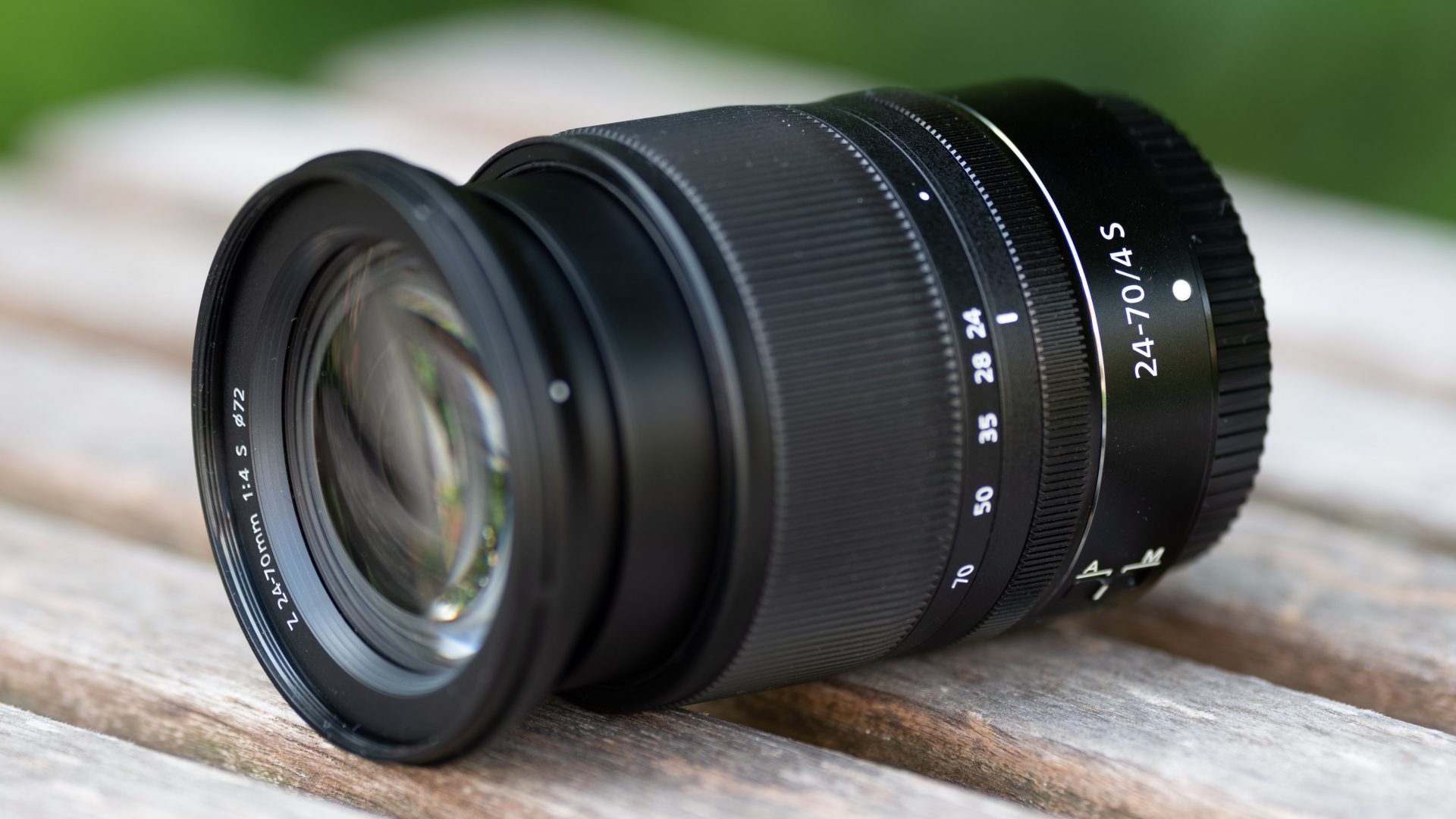
 The Nikon Z 24-70mm f4S is a no-brainer for owners of Z-series mirrorless bodies: optically it is as good as the renowned 24-70mm f2.8E VR with a one stop advantage in image stabilization and almost no loCA. It also delivers very usable close-up performance and retains its high contrast even in contra-light situations. Plus by being roughly half the size and weight it's much more portable and a perfect match for the compact Z-series bodies it's designed for. The new Z Nikkor also focuses as fast and reliably and is sealed as thoroughly as the 24-70mm f2.8E VR. The only drawback of the Z 24-70mm f4S is its relatively ordinary f4.0 focal ratio, but that's easily compensated for by the relatively low price - and did I mention the small size and weight?. So if you're getting a new Z body, be sure to bag yourself this excellent zoom in a kit bundle: Highly Recommended!
The Nikon Z 24-70mm f4S is a no-brainer for owners of Z-series mirrorless bodies: optically it is as good as the renowned 24-70mm f2.8E VR with a one stop advantage in image stabilization and almost no loCA. It also delivers very usable close-up performance and retains its high contrast even in contra-light situations. Plus by being roughly half the size and weight it's much more portable and a perfect match for the compact Z-series bodies it's designed for. The new Z Nikkor also focuses as fast and reliably and is sealed as thoroughly as the 24-70mm f2.8E VR. The only drawback of the Z 24-70mm f4S is its relatively ordinary f4.0 focal ratio, but that's easily compensated for by the relatively low price - and did I mention the small size and weight?. So if you're getting a new Z body, be sure to bag yourself this excellent zoom in a kit bundle: Highly Recommended!



